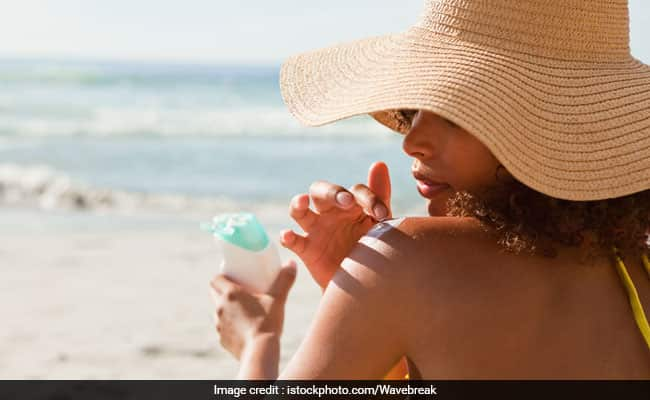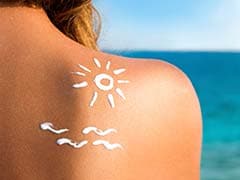Skin tanning: An SPF of 30 is generally good enough but you can also go for higher SPF if advised by your dermatologist. The sunscreen gives you the SPF and this helps the body to react to the UV rays to activate your melanocytes to generate more melanin and hence cause tanning.

Skin tanning: Vitamin c and glycolic acid can help in reversing skin tan
HIGHLIGHTS
- Use a sunscreen of SPF 30
- Products with retinol can help in reducing skin tanning
- You can also get a treatment for skin tanning
People with a darker skin often feel that they tan more easily. Tanning is the natural defense of the body against photodamage that is created by UV radiation. Melanin is the natural pigment that is produced by our body and imparts us our skin colour. Melanin provides the body with natural SPF (that you also see on sunscreens), which is why it is produced by the body as a defense mechanism.
Fitspatrick scale and why you may tan easily
Where does the Fitzpatrick scale come into play here? The Fitzpatrick scale is a scale that was devised in the 1970's after a study into the effects of UV radiation on different skin tones. The lightest skin tones are a I on the Fitzpatrick scale and darkest is VI. The scale rates skin tones from I-VI. This scale tells us that lighter skin tones tend to face a sun burn when exposed to UV radiation and it is the darker skin tones, with more natural melanin that can fight off the sun damage by tanning itself. Also, as Indians we are closer to the equator and the sun's rays have higher levels of UV. So, basically our skin tends to tan more!
Most Indians are between IV-V on the Fitzpatrick scale (although there are exceptions). When the body is exposed to UV radiation, there are two kinds of changes that can take place with regards to melanin. UVA radiation generally leads to oxidation of the existing melanin in the body, which darkens the melanin pigment and is mildly protective. These oxidative changes are usually temporary in nature and reverse within a few days of them taking place. UVB on the other hand leads to melanogenesis or the production of new melanin in the body. These changes generally appear two to three days after the exposure event and are more long-term in nature.
Also read: Skincare Tips: Understanding The Importance Of Exfoliation For Your Skin
How can we reverse tanning?
First and foremost, prevention is better than cure. Probably the most common skin care advice available on the internet (that doesn't take away its importance) is, always wear sunscreen. Always. An SPF of 30 is generally good enough but you can also go for higher SPF if advised by your dermatologist. The sunscreen gives you the SPF and this helps the body to react to the UV rays to activate your melanocytes to generate more melanin and hence cause tanning. UV rays also cause sun damage which leads to sun spots and premature aging. A good sunscreen will protect you against these changes as well.

Wearing a sunscreen can reduce skin tanning
Photo Credit: iStock
Now let's say you didn't use the required protection and are now tanned. Do you have any options to reverse the effects of tanning? The good news is that, yes, you do. However, people often visit skin clinic with years of tanning and sun damage and expect it to be reversed immediately. That does not happen. You need to take proper care of yourself and the results show over time.
One of the easiest ways to help with the reversal of early tanning is the use of topical medications. Ingredients such as Vitamin C, glycolic acid, kojic acid and retinol have all shown to be effective in reversing tan. Speak to your dermatologist to incorporate the right products in your skincare routine to help you tackle your tanning issues.
Also read: 8 Home Remedies To Remove Sun Tan Instantly
If you want quicker results with intervention, there are options for treatments available at skin clinics.
- Microdermabrasion is a treatment where exfoliation is done with the help of a USFDA approved machine. This helps to get rid of dead skin cells from the surface. However, care must be taken after this because the dead cells also help against sun damage. After this treatment, avoid going out into the sun immediately and use sunscreen for sure.
- Laser treatment is another option that is considered the gold standard. The laser used to tackle pigmentation is the Q-switch laser. This emits high energy laser beams at the right wavelengths to tackle the desired pigment cells that help in reversion to the natural skin tone.
- It is UV radiation in sunrays that leads to tanning. Pigmentary changes that are caused by tanning can be reversed using the right medications and treatments. However, what is most important is to use sunscreen every day, be it summer, monsoon or winter.
Also read: Top Ways Sunburn And Suntans Are Harming You
(Dr Saumya Shetty Hegde is a Dermatologist, Cosmetologist and Trichologist at SkinGenious Chembur)
Disclaimer: The opinions expressed within this article are the personal opinions of the author. NDTV is not responsible for the accuracy, completeness, suitability, or validity of any information on this article. All information is provided on an as-is basis. The information, facts or opinions appearing in the article do not reflect the views of NDTV and NDTV does not assume any responsibility or liability for the same.
DoctorNDTV is the one stop site for all your health needs providing the most credible health information, health news and tips with expert advice on healthy living, diet plans, informative videos etc. You can get the most relevant and accurate info you need about health problems like diabetes, cancer, pregnancy, HIV and AIDS, weight loss and many other lifestyle diseases. We have a panel of over 350 experts who help us develop content by giving their valuable inputs and bringing to us the latest in the world of healthcare.














